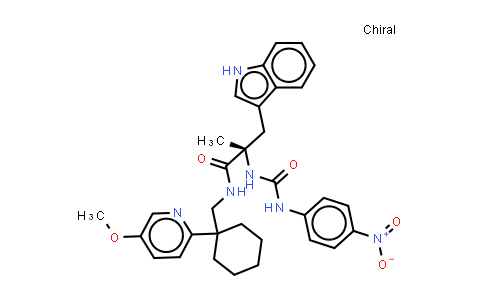
PD176252 NLT 98%
SKU : MC538307
CAS Number : 204067-01-6
Molecular Formula : C32H36N6O5 | Molecular Weight : 584.67
Quote Request| Purity | NLT 98% |
|---|---|
| Storage | at 20ºC 2 years |
* The above information is for reference only.
* If the product has intellectual property rights, a license granted is must or contact us.
| Chemical Name | PD176252 |
|---|---|
| CAS Number | 204067-01-6 |
| MDL Number | MFCD09971099 |
| Molecular Formula | C32H36N6O5 |
| Molecular Weight | 584.67 |
PD176252 is a potent antagonist of neuromedin-B preferring (BB1) and gastrin-releasing peptide-preferring (BB2) receptor with Kis of 0.17 nM and 1 nM for human BB1 and BB2 receptors, and 0.66 nM, 16 nM for Rat BB1 and BB2 receptors, respectively; PD176252 is also an agonist of N-Formyl peptide receptor1/2 (FPR1/FPR2), with EC50s of 0.31 and 0.66 μM in HL-60 cells. IC50 & Target: Ki: 0.17 nM (Human BB1 receptor), 0.66 nM (Rat BB1 receptor), 1 nM (Human BB2 receptor), 16 nM (Rat BB2 receptor)[1]
EC50: 0.31 μM (FPR1), 0.66 μM (FPR2)[2] In Vitro: PD176252 is a potent antagonist of neuromedin-B preferring (BB1) and gastrin-releasing peptide-preferring (BB2) receptor with Kis of 0.17 nM and 1 nM for human BB1 and BB2 receptors, and 0.66 nM, 16 nM for Rat BB1 and BB2 receptors, respectively. PD176252 inhibits acidification responses to neuromedin-B or neuromedin-C at the human BB1 or BB2 receptors expressed in CHO cells, with the appKBs of 4.0 nM or 13 nM, and blocks bombesin-evoked increases in intracellular calcium levels in CHO cells stably expressing human BB1 or BB2 receptors, with appKBs of 2.3 nM and 36 nM, respectively. PD176252 is also an agonist of N-Formyl peptide receptor1/2 (FPR1/FPR2), with EC50s of 0.31 and 0.66 μM in HL-60 cells. PD176252 activates Ca2+ mobilization in HL-60 cells transfected with human FPRs (EC50, 0.72 ± 0.21 μM)[2]. PD176252 inhibits little specific 125I-gastrin releasing peptide binding to NCI-H345 cells at 1 nM and suppresses almost all specific bindings at 1000 nM, with an IC50 of 30 nM. PD176252 (10, 30 μM) significantly inhibits the growth of NCI-H345 or H1299 cells, with IC50s of 7 and 5 μM[3]. In Vivo: PD176252 (1, 10 μg, p.o.) potently inhibits the growth of the proliferation of NCI-H1299 xenografts in nude mice[3].
Related Products
© Copyright 2015-2024 Hangzhou MolCore BioPharmatech Co.,Ltd. All rights reserved.
